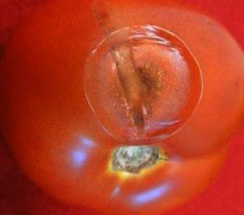Post Harvest Diseases:: Vegetables:: Tomato
| Anthracnose: Colletotrichum coccoides, C. gloeosporoides, C. dematium |
Symptom:
- Ripe to overripe fruit - can cause serious lossesS
- Fruit infection - during green stages but disease develop. ripening.
- Small lesions are circular & depressed-enlarge to greater than 12 mm in dia with zonate markings.
- Lesion surface may appear salmon-colored due to spore production and be dotted with black specks
- Infected fruit have a short shelf life.
|
 |
 |
 |
 |
| Circular and depressed leisons |
Enlarged leisons |
Sporulation |
Black specks |
|
Identification of pathogen:
Fungus:
- Colonies - darkly pigmented with white aerial mycelium, consisting of numerous black sclerotia
- Sclerotia - setose, spherical
- Conidia - straight, fusiform, attenuated at the ends
- Appressoria - clavate, brown, variable in shape
Favourable condition:
- Opt temp- 28 to 32°C
- Remain latent in green fruits until fruits approach ripening stage
- RH-85 to100%
Spread and survival:
- Persist on alternate hosts, crop debris & some weeds
- Alternate hosts - solanaceous crops (potato, eggplant),cucurbits & soybean
- Fungus is also seed-borne
- Spores are usually dispersed by splashing rain
- Fruits - near the soil surface are most likely to become infected
- Overhead irrigation - favor development of anthracnose because of RH & increased duration of leaf wetness
|
Management:
- Crop rotation with non-host crops and avoid potato, soybean, eggplant & cucurbit
- Stake plants to improve air circulation and to reduce leaf and fruit wetness
- Mulch to reduce soil splash onto fruit and lower leaves
- Minimize or avoid overhead irrigation to reduce periods of wetness on fruit
- Hot water treatment - at 50°C for 25 min
- Following treatment, plunge the hot seeds into cold water, dry on paper, and dust with thiram
|
Content validator:
Dr. M. Deivamani, Assistant Professor, Horticulture Research Station, Yercaud-636602.
Source of Images:
http://www.ct.gov/caes/lib/caes/documents/publications/fact_sheets/plant_pathology_and_ecology/anthracnose_of_tomato_04-01-13.pdf
http://203.64.245.61/web_crops/tomato/anthracnose.pdf |
|




